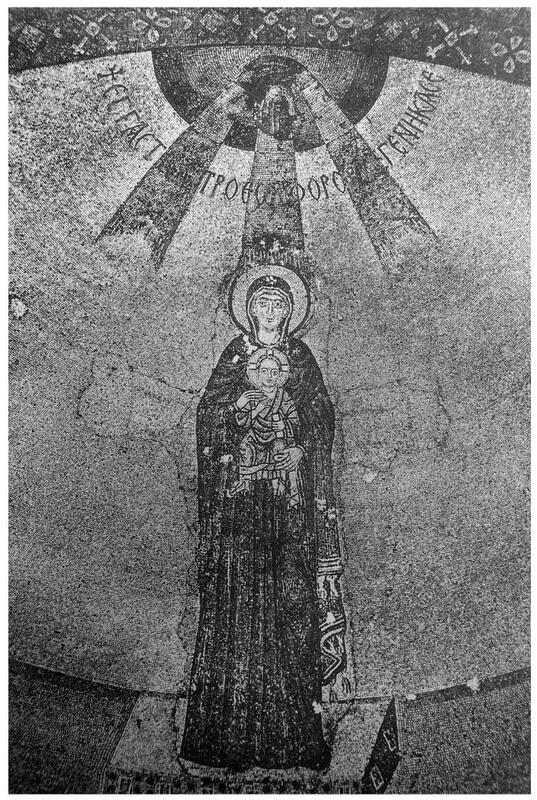Koimesis Church, Nicaea
Date:
Seventh/eighth to ninth century
Location or Findspot (Modern-Day Country):
Turkey
Description:
A monastery dedicated to the koimesis of the Theotokos was founded by a monk-priest named Hyakinthos recorded in a dedicatory inscription in the monastery katholikon. No date is given, but Hyakinthos appears on a list of attendees at the seventh ecumenical council held at Nicaea in 787, so the monastery was likely founded before that date, possibly after a devastating earthquake in 740 but perhaps already in the seventh century.
The three-apsed, domed church was destroyed in 1922, and its mosaic decoration survives only in old photographs. These clearly show disturbed tesserae in the apse conch, indicating that the standing Virgin and Child still visible in the twentieth century had replaced an earlier image of the cross. The Theotokos image must postdate the Triumph of Orthodoxy in 843, when a comparable image was also inserted into the apse at Hagia Sophia. It is possible that in the eighth century the iconoclasts replaced an earlier figure of Mary with the nonfigural cross. Yet they did not disturb the figural images just outside the apse, where pairs of archangels flank the Hetoimasia on the bema arch. The rays of light that emanate from the dove above the throne on the arch echo those that descend from the heavenly semicircle and hand of God in the conch.
Multiple Greek inscriptions in the apse refer to the angelic powers and, typologically, to the power of Christ manifested in the eucharistic liturgy at the altar. An undisturbed vertical inscription between two of the angels says "Naukratios draws the holy icons." Naukratios must have executed the eighth-century mosaics, making this a very rare "signature" by a Byzantine mosaicist.
The three-apsed, domed church was destroyed in 1922, and its mosaic decoration survives only in old photographs. These clearly show disturbed tesserae in the apse conch, indicating that the standing Virgin and Child still visible in the twentieth century had replaced an earlier image of the cross. The Theotokos image must postdate the Triumph of Orthodoxy in 843, when a comparable image was also inserted into the apse at Hagia Sophia. It is possible that in the eighth century the iconoclasts replaced an earlier figure of Mary with the nonfigural cross. Yet they did not disturb the figural images just outside the apse, where pairs of archangels flank the Hetoimasia on the bema arch. The rays of light that emanate from the dove above the throne on the arch echo those that descend from the heavenly semicircle and hand of God in the conch.
Multiple Greek inscriptions in the apse refer to the angelic powers and, typologically, to the power of Christ manifested in the eucharistic liturgy at the altar. An undisturbed vertical inscription between two of the angels says "Naukratios draws the holy icons." Naukratios must have executed the eighth-century mosaics, making this a very rare "signature" by a Byzantine mosaicist.
Relevant Textbook Chapter(s):
4,
5
Image Credits:
Photographs of the mosaics from Theodor Schmit, Die Koimesis-Kirche von Nikaia: Das Bauwerk und die Mosaiken (Berlin, 1927).




